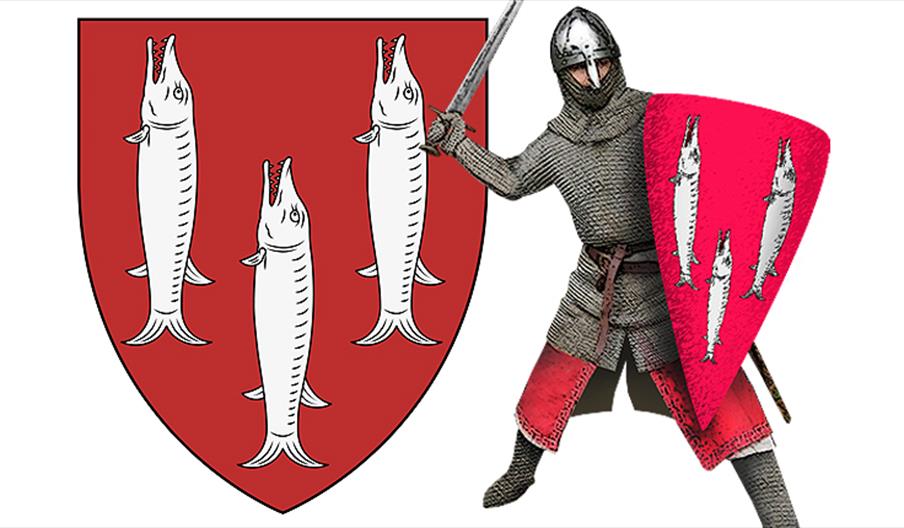Book Tickets Online
About
Richard de Lucy
The medieval footprint that we see today in Ongar, is that of the castle and town that was created by Richard de Lucy, in his day the most powerful man in England being left in charge of the country when his king, Henry II was away. Henry's kingdom was the length of England, and then that of France down to the Spanish border. He had rebellious sons who waged war with him in France. So he was away often, protecting his realm. As well as his castle in Ongar, Richard had land in Cornwall and Devon and Norfolk and Kent, as well as in other parts of Essex. He also had land in Normandy including Luce where he and most of his children were born. He lived during a turbulent time in England and Normandy. Henry I, who he would have known as a young man growing up in the shadow of Henry's castle at Domfront, had died leaving a daughter, Matilda, as his heir. Once dead, his barons were split over succession and some rushed to crown Stephen of Blois (a relative of William the Conqueror) instead. Thus began a civil war between Stephen and Matilda that threw the country into chaos known as The Anarchy. Richard supported Stephen and stayed loyal and close to him throughout the conflict. Many barons used the civil war as an excuse to settle personal scores with rival barons or take advantage of the conflict to capture wealth and power by changing sides as it suited their purpose. However Richard remained true to one cause and served Stephen even when he was held captive by Matilda. It’s probably this loyalty, and his success as a soldier, that led Henry II to entrust him with the transfer of power when Stephen died, and later to give him charge of the country in his absence. Richard was well connected to Kings, to noble families and the church, and he acquired great wealth during his life. He had a regret, and this was his part in supporting Henry II against Thomas Becket, who in return had excommunicated him. After Thomas was martyred in Canterbury Cathedral by knights loyal to the crown, Richard paid penance by founding a priory to Thomas the Martyr and retired there to died.
Ongar passes from Boulogne to Lucé, in the Orné region of Normandy
When Ongar passed from the Honour of Boulogne to the de Lucy family, it was passed between two great and powerful dynasties. Richard de Lucy was one of the most powerful men in England and ran the country as Chief Justiciar during Henry II’s frequent absences from the country. The de Lucy family had strong ties with both Normandy and England. Fulbert de Lucy had been in charge of guarding Dover Castle and built its Chilham Tower (named after his Kent estates) in 1085.
Richard de lucy was born in around 1110 in the family seat of Lucé, in the Orné region of Normandy. His mother was Aveline, the niece and heiress of William Goth. The castle at Lucé was built on a motte, the remains of which bears a remarkable resemblance to that at Ongar, and would have been under the watchful eye of the castle and walled town of Domfront. In 1092 Domfront had been taken by William the Conqueror’s fourth son Henry, who became Henry 1 of England. Therefore Henry would have been Richard de Lucy’s overlord.
Powerful ties to the church in England
Richard’s family had close ties with the church in England, his brother Walter being the Abbot of Battle Abbey, and a relative of his brother Robert being Geoffrey de Gorron who became Abbot of St. Albans. Richard’s sister Lucy, married William de Chesney, the Sheriff of Oxfordshire, whose brother became Bishop of Lincoln.
Marriage and children
In about 1128, Richard married Rohese at Thorney Green in Suffolk. They had four children. Aveline was born around 1114, in Luce, and she married Odinel de Umfreville of Redesdale, Northumberland. Dionisia was born around 1118, also at Luce, and she married Arnold Mountenay in Normandy. Geoffrey was also born around 1118 at Ongar and he became Bishop of Winchester. Finally, Hubert De Lucy was born around 1122 in Luce, and he died without issue.
The Anarchy
The civil war that broke out in England 1135 was also spread to possessions in France. In 1138 Richard de Lucy was in charge of King Stephen’s castle at Falaise which was attacked and put under siege by Geoffrey of Anjou. The castle was well provisioned and armed so the siege only lasted eighteen days before the besieging army fled. Leaving Falaise Richard went to fight in Cornwall with the army of Count Alan of Brittany. Victory brought Richard lands in Cornwall and he built a castle in Turo (the castle was later passed to Reginald de Dunstanville when he was made first Earl of Cornwall by King Stephen). Having moved to England, Richard was constantly at King Stephen’s side during the fighting against Matilda and routed her army at Wallingford. He was with Stephen at Oxford, Norwich and London in 1139 and at Lincoln from 1140 to 1141, spending Christmas with him in Canterbury that same year. During this time he witnessed 135 of Stephen’s charters. In 1143 King Stephen made Richard Justiciar and Sheriff of Essex.
A new King and position of power
The civil war ended in 1153 with the treaty of Winchester, an agreement that King Stephen would reign and upon his death, Matilda’s son Henry would become king. Stephen only lived another year. As part of the agreement, Richard de Lucy had sworn an oath that upon Stephen’s death, he would ensure that the crown passed to Henry along with control of the Tower of London (which he had been given), Windsor castle and the backing of the church. It is reported that, as additional insurance, Richard gave his son into Henry’s care as hostage. He was the sole witness to the coronation charter of Henry II in 1154 and, having carried out all his duties faithfully, Henry confirmed all the rights bestowed upon him by King Stephen and granted him the Hundred of Ongar along with other manors in Essex. Henry II visited Richard at Ongar in the spring of 1157, granting him additional rights to 100 acres of the royal forest in Stanford (now called Stanford Rivers), Greensted and Ongar. In 1162 Henry II appointed Richard joint Justiciar of England alongside Robert de Beaumont. When Robert de Beaumont died in 1168 Richard became sole Justiciar, the most powerful man in England beside the king, and ran the country when Henry was absent, which was often given that his lands stretched from the Scottish borders to those with Spain and he was constantly at war with his sons in France. Richard held this post almost up to his death, relinquishing it in 1179 to enter the abbey which he had founded a year previously, where he died three months later.
Richard's vast estates
During his life, as well as Ongar and surrounding lands and manors in Essex, Richard de Lucy acquired many other lands which brought with them wealth and knights who were granted rights in return for loyalty, fees and service. In 1135 King Henry I granted him Diss in Norfolk as payment for his services. He also had other lands in Norfolk at Stow (now called Stow Bardolph). In return for his defence of Falaise Castle, King Stephen rewarded Richard with thirteen additional knight's fees in Essex. In 1152 Stephen granted him the valuable right to hold a market at Diss. As well as his lands in Cornwall (making up a third of his wealth upon his death), Richard had lands in Devon and Newington and Marden near Maidstone in Kent as well as other lands in Kent and in Rainham in Essex. In 1172 records show that Richard also held 19 knight's fees in Normandy, including Montmartin-sur-Mer and was Lord of Gouviz and Baron Crétot.
Involvement with the Martyrdom of Thomas Becket
As Justiciar of England, Richard de Lucy supported Henry II in his dealings and conflict with Thomas Becket, Archbishop of Canterbury. He was the author of the Constitutions of Clarendon which stated that clerics found guilty of crime in church courts should be punished by the crown, in direct contradiction of Becket’s belief that these were powers for the church alone. For this Richard de Lucy was twice excommunicated by Becket which infuriated the King and added to his grievances that led to Becket’s murder by knights loyal to the crown. In penance for his part in Becket’s martyrdom, Richard founded a priory, dedicated to Becket, in Kent.
Lesnes Abbey and Richard's death
It was shortly before his death, that Richard de Lucy founded the priory of Westwode dedicated to St Thomas the Martyr, later to be known as Lesnes Abbey of St Mary and St Thomas the Martyr, on 11th June 1178. He retired there as a canon in 1179 and died and was buried in the Abbey Chapter House on 14th July 1179. His epitaph read: "Richard the Lucy's light is snatched to shade; To Justice, Peace and State his court was paid. Christ with Thy saints & Thee his rest be made. July's twice seventh on the world did shine, The yr eleven hundred seventy nine." As part of its foundation, Richard had granted to the priory his churches at Newington (St. Mary the Virgin) and Marden and upon his death Henry II granted Richard’s church at Rainham (St. Helen & St. Giles), and his brother granted the church he had built at Elmdon (St Nicholas) in Essex. Lesnes was, and remained, a small abbey with just twelve monks. It continued to be supported by the de Lucy family for two centuries and was finally closed by Cardinal Wolsey in 1525. The remains of the abbey and grounds now form Lesnes Abbey Wood in the London Borough of Bexley.
Find out more about the de Lucy family here: www.lucey.net/webpage56.htm#sn21
Notes on the photos above. The arms of Richard del Lucy are three pike on a red background. His seal was a single pike. The knight is shown in armour typical of the period - not much changed from the time of the conquest in 1066 except that by the end of the 12th century, mail was beginning to cover the arms and hands, legs and feet, and the kite shaped shield evolved to a style known as 'heater' shields (due to the shape being similar to the base of an iron). The pictures of Domfront castle show how important and powerful it was. The attached town was well fortified with walls and towers. The depiction of the death of Thomas Becket in Canterbury Cathedral is one of many such illustrations made of this key historic event.The abbey at Lesnes is now a ruin but traces of the buildings and some features still remain as does part of the ancient forest alongside.
Find out more about Medieval Ongar here.
Find out more about Richard's predecessors at Ongar, the Counts of Boulogne here.
















